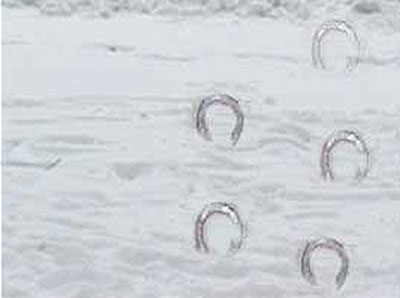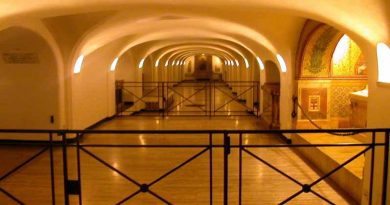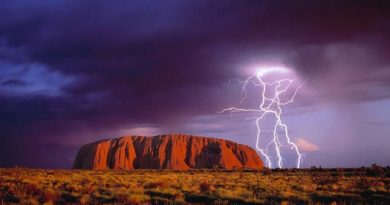The Devil’s Footprints
The Devils Footprints was the name given to a peculiar phenomenon that occurred in Devon, England on 8 February 1855. After a light snowfall, during the night, a series of hoof-like marks appeared in the snow. These footprints, measuring 1.5 to 2.5 inches wide and eight inches apart, continued throughout the countryside for a total of over 100 miles, and, although veering at various points, for the greater part of their course followed straight lines. Houses, rivers, haystacks and other obstacles were travelled straight over, and footprints appeared on the tops of snow-covered roofs and high walls which lay in the footprints path, as well as leading up to and exiting various drain pipes of as small as a four inch diameter. Reports of similar anomalous, obstacle-unheeded footprints exist from other parts of the world, although none is of such a scale as that of the case of the Devils Footprints.
Incident
On the night of 89 February 1855 and one or two later nights, after a light snowfall, a series of hoof-like marks appeared in the snow. These footprints, measuring 1.5 to 2.5 inches wide and eight inches apart, continued throughout the countryside for a total of over 100 miles, and, although veering at various points, for the greater part of their course followed straight lines.Houses, rivers, haystacks and other obstacles were travelled straight over, and footprints appeared on the tops of snow-covered roofs and high walls which lay in the footprints’ path, as well as leading up to and exiting various drain pipes of as small as a four inch diameter.
The area in which the prints appeared extended from Exmouth, up to Topsham, and across the river Exe to Dawlish and Teignmouth. R.H. Busk, in an article published in Notes and Queries decades later, stated that footprints also appeared further afield, as far south as Totnes and Torquay, and that there were other reports of the prints further afield in Weymouth (Dorset) and even Lincolnshire. In each case, the prints would go on for miles and miles before abruptly stopping.
There were also attendant rumours about sightings of a “devil-like figure” in the Devon area during the scare. Many townspeople armed themselves and attempted to track down the beast responsible, without success.
Theories
Many explanations have been put forward for the incident. Some investigators are sceptical that the tracks really extended for over a hundred miles, arguing that no-one would have been able to follow their entire course in a single day. Another reason for scepticism, as Joe Nickell points out, is that the eye-witness descriptions of the footprints varied from person to person.
Balloon
Author Geoffrey Household suggested that “an experimental balloon” released by mistake from Devonport Dockyard had left the mysterious tracks by trailing two shackles on the end of its mooring ropes. His source was a local man, Major Carter, whose grandfather had worked at Devonport at the time. Carter claimed that the incident had been hushed up because the balloon also wrecked a number of conservatories, greenhouses, and windows before finally descending to earth in Honiton.
While this could explain the shape of the prints, sceptics have disagreed about whether the balloon could have travelled such a random zigzag course without its trailing ropes and shackles becoming caught in a tree or similar obstruction.
Hopping mice
Mike Dash, in an article published in Fortean Studies, suggests that at least some of the prints, including some of those found on rooftops, could have been made by hopping rodents such as wood mice. The print left behind after a mouse leaps resembles that of a cloven animal, due to the motions of its limbs when it jumps. Dash states that the theory that the Devon prints were made by rodents was originally proposed as long ago as March 1855, in The Illustrated London News.
Hysteria
It is also often suggested that the footprints were merely a case of mass hysteria, caused by the sighting of various different animal tracks and lumping them together as one.
Kangaroo
In a letter to the Illustrated London News in 1855, Rev. G.M. Musgrave wrote: “In the course of a few days a report was circulated that a couple of kangaroos escaped from a private menagerie (Mr. Fische’s, I believe) at Sidmouth.” It seems, though, that nobody ascertained whether the kangaroos had escaped, nor how they could have crossed the Exe estuary.
Similar incidents
On the night of March 12, 2009, more strange marks, corresponding to those left in 1855, were found again in Devon. Comparative analysis shows similar markings. Reports of similar anomalous, obstacle-unheeded footprints exist from other parts of the world, although none is of such a scale as that of the case of the Devil’s Footprints.
Among the high mountains of that elevated district where Glenorchy, Glenlyon and Glenochay are contiguous, there have been met with several times, during this and also the former winter, upon the snow, the tracks of an animal seemingly unknown at present in Scotland. The print, in every respect, is an exact resemblance to that of a foal of considerable size, with this small difference, perhaps, that the sole seems a little longer, or not so round; but as no one has had the good fortune as yet to have obtained a glimpse of this creature, nothing more can be said of its shape or dimensions; only it has been remarked, from the depth to which the feet sank in the snow, that it must be a beast of considerable size. It has been observed also that its walk is not like that of the generality of quadrupeds, but that it is more like the bounding or leaping of a horse when scared or pursued. It is not in one locality that its tracks have been met with, but through a range of at least twelve miles.
The Times, March 14, 1840
In the Illustrated London News, March 17, 1855, a correspondent from Heidelberg wrote, “upon the authority of a Polish Doctor in Medicine,” that on the Piaskowa-góra (Sand Hill) a small elevation on the border of Galicia, but in Congress Poland, such marks are to be seen in the snow every year, and sometimes in the sand of this hill, and “are attributed by the inhabitants to supernatural influences.”
There have been many incidents of strange footprints with cloven hoofs appearing without an obvious cause. Most occur during or after a fierce electrical storm. Some of these are linked to the legend of Kui found in the Shanhaijing, a mythical monster with one leg like a cloven hoof that looks similar to that of a cow, except with one foot. Fierce electrical storms heralded its presence.
This phenomenon is also linked to the legends of Sciapods.



